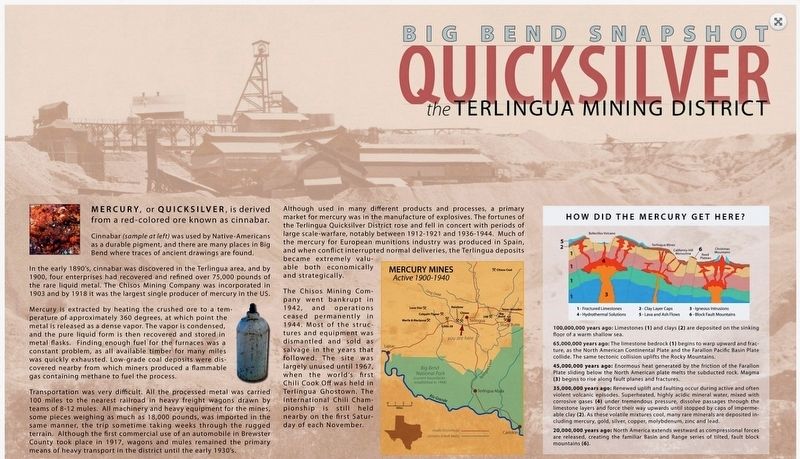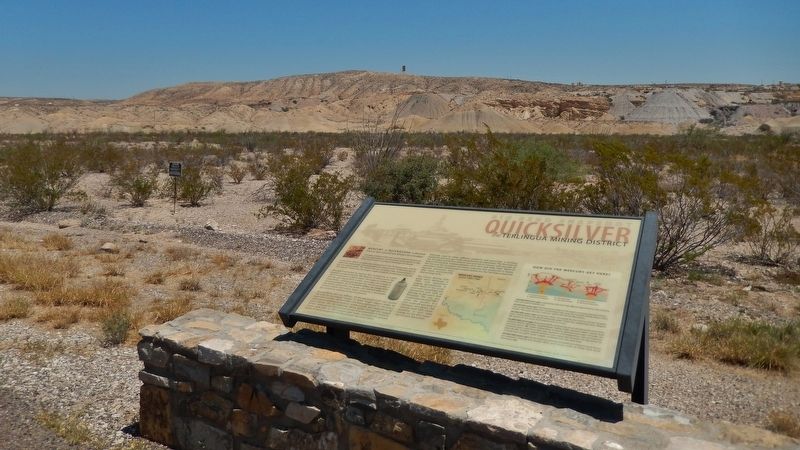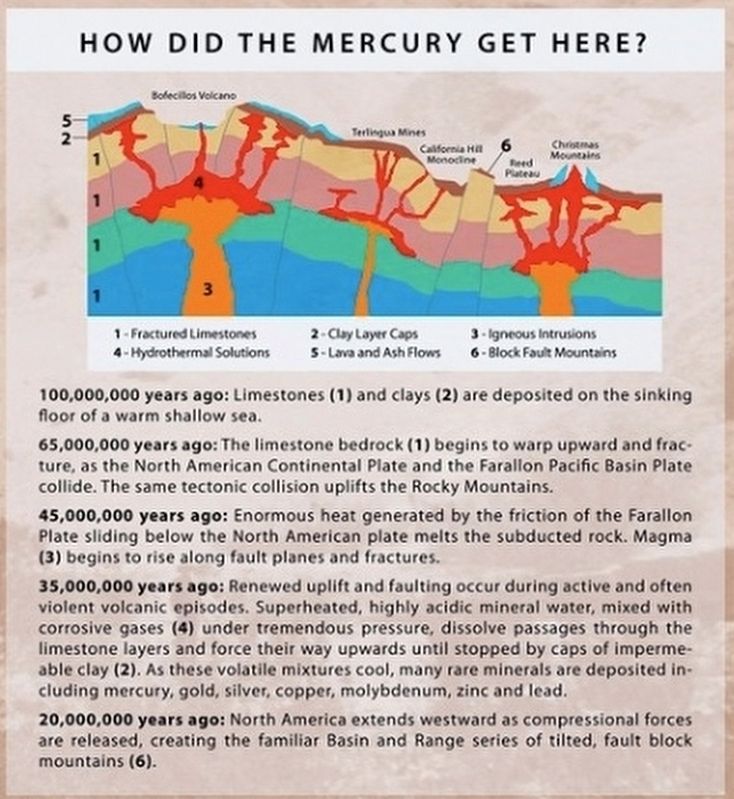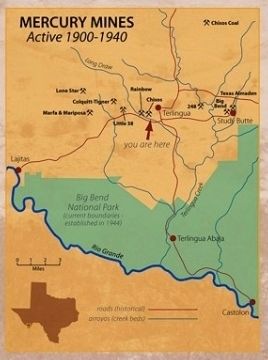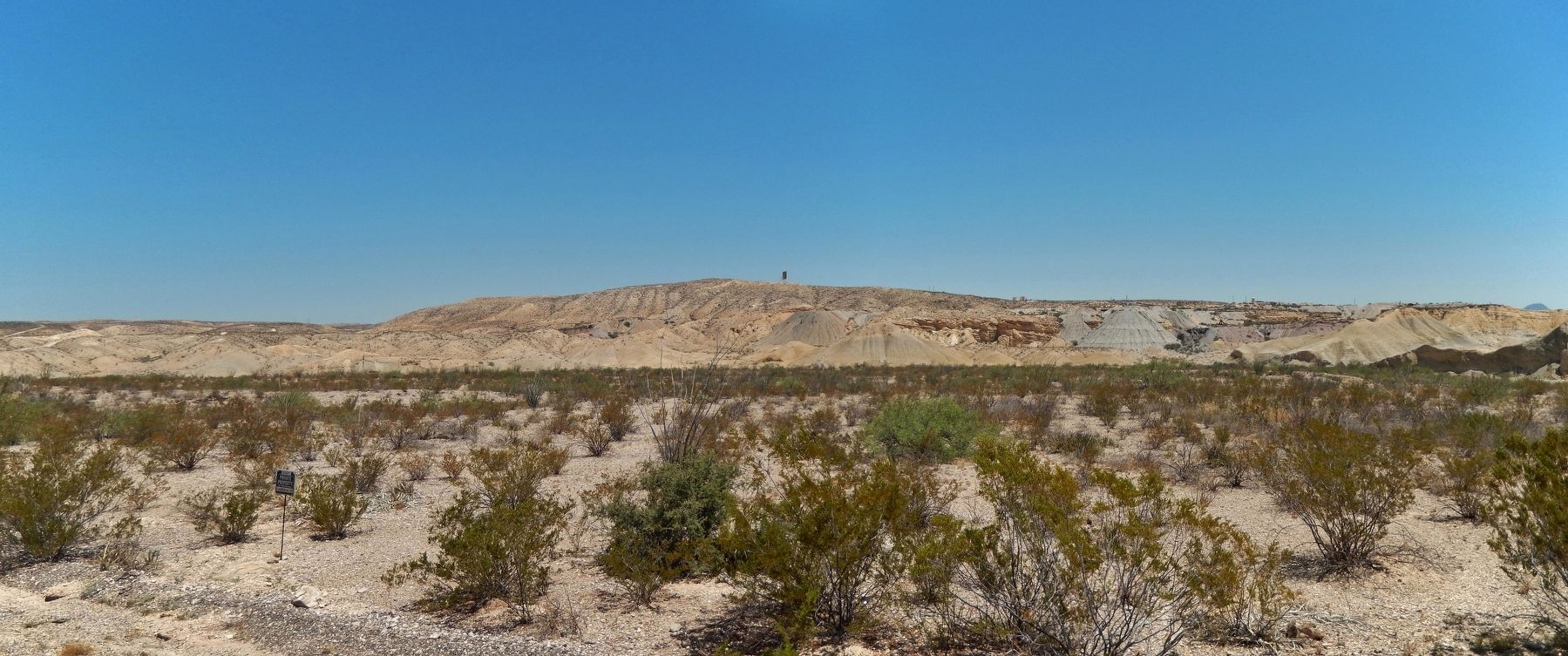Terlingua in Brewster County, Texas — The American South (West South Central)
Quicksilver
the Terlingua Mining District
Mercury, or Quicksilver, is derived from a red-colored ore known as cinnabar.
Cinnabar (sample at left) was used by Native-Americans as a durable pigment, and there are many places in Big Bend where traces of ancient drawings are found.
In the early 1890’s, cinnabar was discovered in the Terlingua area, and by 1900, four enterprises had recovered and refined over 75,000 pounds of the rare liquid metal. The Chisos Mining Company was incorporated in 1903 and by 1918 it was the largest single producer of mercury in the US.
Mercury is extracted by heating the crushed ore to a temperature of approximately 360 degrees, at which point the metal is released as a dense vapor. The vapor is condensed, and the pure liquid form is then recovered and stored in metal flasks. Finding enough fuel for the furnaces was a constant problem, as all available timber for many miles was quickly exhausted. Low-grade coal deposits were discovered nearby from which miners produced a flammable gas containing methane to fuel the process.
Transportation was very difficult. All the processed metal was carried 100 miles to the nearest railroad in heavy freight wagons drawn by teams of 8-12 mules. All machinery and heavy equipment for the mines, some pieces weighing as much as 18,000 pounds, was imported in the same manner, the trip sometime taking weeks through the rugged terrain. Although the first commercial use of an automobile in Brewster County took place in 1917, wagons and mules remained the primary means of heavy transport in the district until the early 1930’s.
Although used in many different products and processes, a primary market for mercury was in the manufacture of explosives. The fortunes of the Terlingua Quicksilver District rose and fell in concert with periods of large-scale warfare, notably between 1912-1921 and 1936-1944. Much of the mercury for European munitions industry was produced in Spain, and when conflict interrupted normal deliveries, the Terlingua deposits became extremely valuable both economically and strategically.
The Chisos Mining Company went bankrupt in 1942, and operations ceased permanently in 1944. Most of the structures and equipment was dismantled and sold as salvage in the years that followed. The site was largely unused until 1967, when the world’s first Chill Cook Off was held in Terlingua Ghost Town. The International Chill Championship is still held nearby on the first Saturday of each November.
(sidebar)
How did the Mercury get here?
100,000,000 years ago: Limestones (1) and clays (2) are deposited on the sinking floor of a warm shallow sea.
65,000,000 years ago: The limestone bedrock (1) begins to warp upward and fracture, as the North American Continental Plate and the Farallon Pacific Basin Plate collide. The same tectonic collision uplifts the Rocky Mountains.
45,000,000 years ago: Enormous heat generated by the friction of the Farallon Plate sliding below the North American Plate melts the subducted rock. Magma (3) begins to rise along fault planes and fractures.
35,000,000 years ago: Renewed uplift and faulting occur during active and often violent volcanic episodes. Superheated, highly acidic mineral water, mixed with corrosive gases (4) under tremendous pressure, dissolve passages through the limestone layers and force their way upwards until stopped by caps of impermeable clay (2). As these volatile mixtures cool, many rare minerals are deposited including mercury, gold, silver, copper, molybdenum, and lead.
20,000,000 years ago: North America extends westward as compressional forces are released, creating the familiar Basin and Range series of tilted, fault block mountains (6).
Topics. This historical marker is listed in these topic lists: Industry & Commerce • Native Americans • War, World I • War, World II.
Location. 29° 18.72′ N, 103° 37.377′ W. Marker is in Terlingua, Texas, in Brewster County. Marker is on Farm to Market Road 170, 0.7 miles west of SE Longdraw, on the right when traveling west. Located in a pull-out on the north side of the highway. Touch for map. Marker is in this post office area: Terlingua TX 79852, United States of America. Touch for directions.
Other nearby markers. At least 8 other markers are within 8 miles of this marker, measured as the crow flies. Terlingua Cemetery (approx. 0.8 miles away); Chisos Mine and Terlingua (approx. 0.8 miles away); Federico Villalba (approx. 0.8 miles away); Terlingua (approx. 1.1 miles away); Ranching in the Big Bend (approx. 5.4 miles away); Big Bend Ranching: South (approx. 5.4 miles away); E.E. Townsend (approx. 6.9 miles away); Terlingua Abaja (approx. 8 miles away). Touch for a list and map of all markers in Terlingua.
Also see . . .
1. Chasing Quicksilver History in Beautiful Big Bend. From about 1900 to 1950, the Big Bend region was one of America’s top producers of mercury, also known as quicksilver, an element extracted from cinnabar ore that was once a key ingredient in detonators. About a dozen mines operated in the Terlingua Quicksilver District, which covered parts of Presidio and Brewster counties. Mining companies dug shafts hundreds of feet deep and lugged out cinnabar by hand, cart, and burro (Submitted on December 14, 2017, by Cosmos Mariner of Cape Canaveral, Florida.)
2. Terlingua, Texas. Quicksilver production peaked during World War I. By 1922 40 percent of the quicksilver mined in the United States came from Terlingua, but production began to decline steadily during the 1930s. On October 1, 1942, the Chisos Mining Company filed for bankruptcy. A successor firm ceased operations at the end of World War II when most of the population dispersed. Terlingua became a ghost town. (Submitted on December 14, 2017, by Cosmos Mariner of Cape Canaveral, Florida.)
3. Mariscal Mine. Mercury or "quicksilver," as it is known commercially, is the only metal that appears in liquid form at ordinary temperatures. Centuries of use as an amalgam to process precious metals, a detonator for explosives, an electrical conductor, and an agent for dental and medical preparations, made the enigmatic metal a highly valued commodity. While California was the first United States producer of mercury beginning in 1824, the industry advanced to West Texas by the end of the 1800s. From 1900 to 1930, the Terlingua Mining District, which borders present Big Bend National Park on the west, accounted for approximately one-third of the total U.S. output. (Submitted on December 15, 2017, by Cosmos Mariner of Cape Canaveral, Florida.)
Credits. This page was last revised on December 17, 2017. It was originally submitted on December 14, 2017, by Cosmos Mariner of Cape Canaveral, Florida. This page has been viewed 518 times since then and 54 times this year. Photos: 1, 2. submitted on December 14, 2017, by Cosmos Mariner of Cape Canaveral, Florida. 3, 4, 5. submitted on December 15, 2017, by Cosmos Mariner of Cape Canaveral, Florida. • Bernard Fisher was the editor who published this page.
